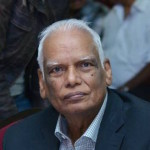The Constitutional Process Gives Sri Lanka A Real Chance

By Veluppillai Thangavelu –January 16, 2017
The Constitutional Process Gives Sri Lanka a Real Chance to Move Forward or Get Stuck in the Troubled Past
The year 2017 is a make or break year for the National Unity government and the Tamil people. In the history of Sri Lanka, an attempt is made for the third time after independence to enact a new constitution to resolve three major protracted issues facing the country. They are (1) devolution of power, (2) electoral reform, and (3) restructuring the executive presidential system.
Undoubtedly, devolution of power is the critical and the fundamental element of the constitution making process. It directly affects the future political and economic well being of not only the
Tamil people, but the entire people of Sri Lanka. Power sharing has become a contentious issue right after independence and continues to pose a challenge to ethnic reconciliation.
The major difference between the 1972 and 1978 constitution is the participation of elected representatives of the Tamil people in the constitutional process. The previous constitutions completely ignored demands by the Tamil people for power sharing. Maximum autonomy for the Tamil people in their traditional habitat to manage their own affairs under a federal structure.
Anton Balasingham proposed to G.L. Peiris the chief negotiator for government of Srilanka “To explore a possible solution based on internal self determination of Tamils on a federal basis to lands of historic habitation of Tamil speaking people”. An agreement was reached between the LTTE and the UNP-led United National Front (UNF) government in December, 2002 at the third round of talks at Oslo. It was popularly called the Oslo Declaration and the Minister of Constitutional Affairs Prof. Peiris hailed the agreement as a ‘paradigm shift’ on Sri Lanka’s vexed ethnic question.
Anton Balasingham proposed to G.L. Peiris the chief negotiator for government of Srilanka “To explore a possible solution based on internal self determination of Tamils on a federal basis to lands of historic habitation of Tamil speaking people”. An agreement was reached between the LTTE and the UNP-led United National Front (UNF) government in December, 2002 at the third round of talks at Oslo. It was popularly called the Oslo Declaration and the Minister of Constitutional Affairs Prof. Peiris hailed the agreement as a ‘paradigm shift’ on Sri Lanka’s vexed ethnic question.
The agreement stated “Responding to a proposal by the leadership of the LTTE, the parties have agreed to explore a political solution founded on the principle of internal self-determination in areas of historical habitation of the Tamil-speaking peoples, based on a FEDERAL structure within a united Sri Lanka. The parties acknowledged that the solution has to be acceptable to all communities.” Federalism became entrenched in the political discourse in Sri Lanka’s political circles when it was endorsed at the Tokyo donor conference in 2003. The Tokyo Declaration, signed by 70 state and multilateral donors, commended the LTTE and the Colombo government “for their commitment to a lasting and negotiated peace based on a federal structure within a united Sri Lanka.”
However, G.L. Peiris has since made a U turn distancing himself from the terms of the Oslo Agreement, saying words like federalism and unitary were “meaningless.” Likewise, the United National Party led by Ranil Wickremesinghe also ditched the federal constitutional model as a solution in 2007 due to repeated defeats at the polls. However, Ravi Karunanayake, UNP MP claimed “Our party stands for maximum devolution of power and when the Ceasefire Agreement was signed by the UNP government of 2001 we did not have a Federal solution in mind, but only a mode of maximum devolution of power to solve the problem.” The UNP came under mounting pressure from its rank and file to reclaim the Sinhala nationalist vote by swinging to the right.
The first attempt at decentralising powers within the framework of a unitary constitution was through 13A in 1987. Though inadequate, the provincial councils were considered as autonomous bodies and are not under any Ministry. It derives its authority and power from the Constitution and Acts of Parliament. Undertakes activities which had earlier been undertaken by the Central Government Ministries, Departments, Corporations and Statutory Authorities. But, provincial council’s powers were restricted or diluted because of (1) the inclusion of the concurrence list, and (2) the vesting of executive powers on the Governor and (3) failure on the part of the government to implement the appointment of Land and Police Commissions. Though, ex president Mahinda Rajapaksa made a commitment to UN Secretary Ban-Ki-moon in May, 2009 that he will introduce amendment to the 13A + he never kept his word.
The administration of the provincial councils depends extensively on the goodwill of the central government. Powers devolved under the 13th Amendment were insufficient as the central government maintains a strict control over important subjects of power sharing through the Concurrent List.
The current attempt at drawing a new constitution has been made possible because of the election of Maithripala Sirisena as president in January, 2015 and the change of regime in August of the same year. It was exactly a year ago on January 20; a Resolution on the making of a Constitution was moved in Parliament by the Prime Minister in the parliament. The Resolution converted the parliament into a Constitutional Assembly (CA) comprising all the members of the parliament but sits as a separate body. It is tasked with enacting a new constitution.
